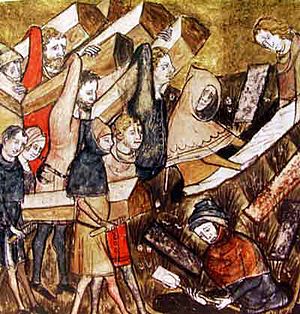Zoonosis facts for kids

Zoonosis (say: zoh-oh-NOH-sis) is a fancy word for a disease that can spread from animals to humans. These diseases are also called zoonotic diseases. They can be caused by tiny living things like bacteria, viruses, fungi, or parasites.
Zoonotic diseases are very common around the world. About 60% of all the infectious diseases that people get actually come from animals.
These diseases can spread in different ways. Sometimes, a sick animal can pass the disease directly to a human. This might happen through a bite, like with rabies, or through the air. This is called direct zoonosis.
Other times, a disease spreads through a vector. A vector is an animal that carries the tiny germ (called a pathogen) that causes the disease, but the vector itself doesn't get sick. Diseases spread this way are called vector-borne diseases.
For example, rats can carry the bubonic plague. But they don't usually infect humans directly. Instead, fleas bite the rats and pick up the plague bacteria without getting sick. If that flea then bites a human, it can pass the bacteria to the human, and the person can get the plague. In this case, the rat is the host (where the germ lives), and the flea is the vector.
Contents
How Zoonotic Diseases Spread
Through Food
Many illnesses you can get from food are zoonotic diseases. This happens when a person gets sick from eating food that came from a sick animal.
Common germs that cause foodborne illnesses are Salmonella, Campylobacter, and Escherichia coli (often called E. coli) bacteria. Foods like eggs, seafood, meat, poultry, and dairy products can carry these bacteria. They can cause illnesses like food poisoning.
Here are some other zoonotic illnesses you can get from eating or drinking:
| Disease | Germ | Animal Host | How it Spreads |
|---|---|---|---|
| Brucellosis | Brucella bacteria | Cattle, goats, sheep, camels | Drinking unpasteurized milk or eating cheese made from it; Eating undercooked meat. |
| Cholera | Vibrio cholerae bacteria | Shellfish | Eating undercooked shellfish. |
| Creutzfeldt-Jakob disease | Prions | Cattle | Eating meat from cattle that had mad cow disease. |
| Listeriosis | Listeria bacteria | Cattle, fish | Drinking unpasteurized milk or eating cheese made from it; Eating undercooked meat or seafood. |
| Toxoplasmosis | Toxoplasma gondii parasite | Pigs, lambs, deer, cattle | Eating undercooked meat. |
You can often avoid foodborne illnesses by cooking meat, seafood, and eggs properly. This kills any harmful bacteria or parasites.
Direct Contact with Animals
Here are some examples of zoonotic diseases that people can get directly from sick, live animals:
| Disease | Germ | Animal Host | How it Spreads |
|---|---|---|---|
| Anthrax | Bacillus anthracis bacteria | Cattle, sheep, goats, camels, horses, pigs | Breathing in anthrax spores or getting them on the skin. |
| Influenza | Influenza A virus | Horses, pigs, birds, seals, whales, and more | Breathing air from infected animals. |
| Lassa fever | Lassa virus | Rodents | Touching rodent feces (poop). |
| Rabies | Rabies virus | Dogs, bats, cattle, monkeys, wolves, and more | Infected saliva from a bite or scratch. |
| Toxoplasmosis | Toxoplasma gondii parasite | Cats | Cat feces (in litter boxes or dirt). |
| Tuberculosis | Mycobacterium bovis bacteria | Cattle, deer, llamas, pigs, cats, and more | Breathing air, or touching sputum, urine, feces, or pus from infected animals. |
Diseases Spread by Vectors
These diseases are spread by a vector, like an insect, that carries the germ from an animal to a human.
| Disease | Germ | Animal Host | Vector |
|---|---|---|---|
| African sleeping sickness | Trypanosoma brucei rhodesiense parasite | Many wild and farm animals | Tsetse fly. |
| Bubonic plague | Yersinia pestis bacteria | Rodents | Fleas. |
| Dengue fever | Flaviviruses | Humans and primates | Aedes mosquitoes. |
| Lyme disease | Borrellia bacteria | Rodents | Ticks. |
| Malaria | Plasmodium parasites | Humans | Mosquitoes. |
| West Nile fever | West Nile virus | Mostly birds | Mosquitoes. |
Related pages
See also
 In Spanish: Zoonosis para niños
In Spanish: Zoonosis para niños

